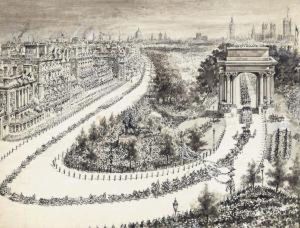Joseph, Nash Jnr. Paintings
Joseph Nash the Younger was an English watercolor painter and illustrator, predominantly known for his work depicting architecture and historical settings. Born on December 17, 1809, in Great Marlow in Buckinghamshire, England, he was the son of Joseph Nash Senior, who was also an artist, and showed artistic talent from an early age.
Nash developed a strong interest in Gothic architecture and historical buildings, which would become the main subjects of his artistic career. He was a pupil of the painter and architect Augustus Charles Pugin, who was a leading figure in the Gothic Revival movement in England. Under Pugin's guidance, Nash honed his skills in architectural drawing and watercolor painting, which allowed him to render buildings with precise detail and atmospheric effect.
Throughout his career, Nash was a prolific artist, and his works were frequently exhibited at the Royal Academy and the Society of Painters in Water Colours, of which he became a full member in 1834. He is particularly remembered for his contributions to publications such as 'The Mansions of England in the Olden Time' (1839-49), a series of illustrated books that presented a romantic and idealized view of England's historic houses and castles. These illustrations were celebrated for their technical accuracy and their evocation of the historical past.
Nash's dedication to the illustration of architectural and historical subjects was not just an artistic endeavor; it also served as a form of historical documentation. Many of the buildings he depicted were in states of disrepair at the time, and some have since been lost or significantly altered. Thus, his work provides valuable insights into the 19th-century appearance of these structures.
Joseph Nash the Younger's contribution to the Victorian understanding of historical architecture and his role in the Gothic Revival movement make him a significant figure in the history of English art. His illustrations continue to be appreciated for their beauty and historical value. Nash passed away on December 19, 1878, leaving behind a rich legacy of artwork that continues to be studied and admired.
